Over the past year, the challenges that teachers, students, and our communities have faced reinforce the value of social and emotional learning, mindfulness, character development, self-compassion, and social justice—and our favorite education books of 2021 explore each of these themes.
If you are looking for practical guides to help you teach mindfulness or infuse social-emotional learning (SEL) into your curriculum, you’ll find two great books below by Linda Yaron Weston and Lorea Martinez. Or if you want to focus on your own well-being, Lisa Baylis’s book Self-Compassion for Educators provides you with self-care tools and practices.
And, if you want to think more deeply about the role of moral and character development in your work, we’ve highlighted three books this year. What are the enduring intellectual virtues that ground us and help us to navigate a topsy-turvy world? How can we educate for human goodness, which is so badly needed right now? Finally, how do the fields of moral development and social justice education complement one another? Read on to learn more.
Mindfulness for Young Adults: Tools to Thrive in School and Life, by Linda Yaron Weston
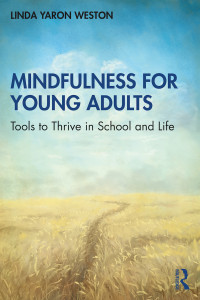 Routledge, 2020, 256 pages.
Routledge, 2020, 256 pages.
For educators across the globe, the current mental health crisis is pressing and palpable, and Linda Yaron Weston’s book Mindfulness for Young Adults offers a range of supports for anyone working with secondary or college-level youth in schools and community organizations.
To start, Yaron Weston cautions us that “mindfulness is not a silver bullet designed to save anyone. It is a field that offers tools to navigate experiences with awareness, acceptance, agency, curiosity, openness, and kindness.” She then thoughtfully addresses a range of youth challenges, backgrounds, and experiences with a holistic, integrated approach to wellness that builds on traditional mindfulness-based programs.
Her workbook can be used as a course text or as an instructional supplement if you are already modeling well-being practices in your classroom, organization, or home. Drawing on her background in yoga, English language arts, physical education, and equity work, USC professor Yaron Weston maps out the benefits of mindfulness by referencing a range of health and psychology research, and philosophers and inspiring thinkers like William James, Maya Angelou, and Fred Rogers, while elevating students’ voices and experiences.
In five modules, she focuses on the principles of mindfulness, the body (including unique breath strategies, as well as goal-setting strategies for healthy living), the heart (fostering joy, navigating difficult emotions, and exploring compassion and self-compassion), the mind (working with thoughts and anxiety to increase resilience), and how to integrate mindfulness into one’s daily life.
If you are familiar with mindfulness curricula, you will be particularly impressed with this book’s developmentally appropriate focus on youth identity and social consciousness. For example, in the “Mind” module, students use reflection activities to explore who they are and what it means to live as an engaged citizen of the world—with an attentiveness to family, culture, gender, and sexuality.
Some mindfulness programs can be faulted for presenting mindfulness techniques in a decontextualized, artificial way as sort of an “add-on” life skill or disposition. However, Mindfulness for Young Adults integrates mindfulness—as a way of being—into the lives of teens and college students to help them navigate the challenges they face right now.
Self-Compassion for Educators, by Lisa Baylis
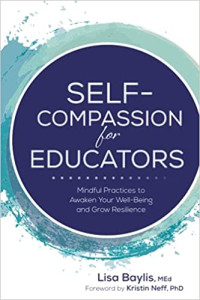 PESI Publishing, Inc., 2021, 264 pages.
PESI Publishing, Inc., 2021, 264 pages.
If you’re looking for a psychological boost as you begin 2022, Lisa Baylis’s Self-Compassion for Educators features stories, reflection activities, and personal practices for any adult who supports student learning. This practical guide focuses on helping school staff learn to embody mindfulness and self-compassion, but it also features Baylis’s AWE (Awaken Wellbeing for Educators) method, including her “Seven C’s of Resilience” (courage, curiosity, clearing our way, community, care, culture, and compassion).
Having struggled with burnout herself, the author shares personal stories of her teaching experiences and her wellness journey, including her own children’s reactions to their mom’s mindfulness practices at home. Well-being isn’t necessarily about “balance,” she says, but responsiveness to the rhythms of life. This rings true—and can release us from the desire to have it all figured out. If we can be aware, adaptable, AND kind to ourselves in the process, the challenges we face as educators may not feel nearly as daunting. Baylis believes you can sustain well-being as you learn “(1) to know when you’re under stress or suffering (mindfulness) and (2) to respond with care and kindness (self-compassion).”
Apart from offering a range of mindfulness and self-compassions practices in her book, Baylis also directs you to a tool that assesses your quality of life and a wellness wheel to help you evaluate seven dimensions of well-being—including the spiritual, social, and intellectual—as well as reflection activities to help you identify your values, write a mission statement, and prioritize time for play in your life, like hiking, dancing, cooking, or just watching cartoons.
If we are well, our students are more likely to be well—and Baylis created this handy resource with the goal of placing “educator well-being at the forefront of school culture.”
Teaching With the Heart in Mind: A Complete Educator’s Guide to Social Emotional Learning, by Lorea Martinez
 Brisca Publishing, 2021, 254 pages. Read an essay adapted from Teaching With the Heart in Mind.
Brisca Publishing, 2021, 254 pages. Read an essay adapted from Teaching With the Heart in Mind.
Knowing that standalone SEL programs aren’t always sensitive to the specific needs of students and schools, districts across the country need resources to help them thoughtfully integrate key SEL skills into more culturally responsive curricula. In Teaching With the Heart in Mind, Lorea Martinez provides concrete tips and strategies for building trust, increasing educators’ cultural competence, and creating safe, emotionally connected spaces for learning.
“Justice is not an afterthought or an add-on to our curriculum but a way of being and relating to ourselves and others in the classroom,” says Martinez. Her book serves as a roadmap for educators, featuring the “why” of SEL—including the four research-based conditions for learning—and the specific SEL skills teachers and students need to thrive in classrooms.
Then, in clear, accessible language, she guides her readers through the “what” and “how” of her “HEART in mind” model, mapping out five key skills (in the intrapersonal, interpersonal, and cognitive realms) with a focus on concrete classroom applications and grade-level “indicators of mastery.”
To support teacher planning, she approaches each SEL skill with multiple implementation examples, including direct instruction (e.g., teaching students how to label and relate to their emotions), integration with teaching practices (e.g., project-based and cooperative learning), and integration with academic content (e.g., character analyses in language arts). In addition, she includes a whole chapter featuring tips for integrating this model into virtual classrooms.
Martinez reminds us that “we cannot separate SEL from effective teaching”—and the tools she provides will be empowering for teachers at all levels. If you are looking for a step-by-step guide to help you and your colleagues build on students’ cultural assets as you incorporate social and emotional skills into academic content and pedagogy, this is it.
Deep in Thought: A Practical Guide for Teaching Intellectual Virtues, by Jason Baehr
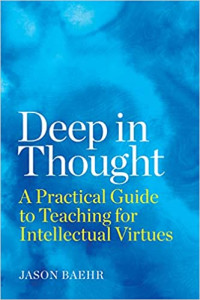 Harvard Education Press, 2021, 256 pages.
Harvard Education Press, 2021, 256 pages.
“What’s the point of what I’m doing? Am I really making a difference? What can I reasonably hope to accomplish as a teacher?”
Deep in Thought responds to these nagging questions in a re-examination of the key aims of education through the lens of intellectual virtues—“the personal qualities and character strengths of good thinkers and learners.” Drawing on extensive psychological research, his work in the field of virtue epistemology, and his experience working with teachers and cofounding the Intellectual Virtues Academy, Jason Baehr presents nine key intellectual virtues and the “principles, practices, and postures” for teaching them.
Here, you’ll learn more about intellectual virtues like curiosity, humility, courage, autonomy, and open-mindedness while exploring why and how they are fundamental to learning and deep understanding. You’ll explore the “postures” (or attitudes) that help you to develop each virtue, and you’ll learn about concrete instructional approaches for teaching each virtue, including targeted language for the classroom (definitions and slogans), and self-reflection and assessment tools, as well as questioning and perspective-taking practices you can incorporate into daily lessons.
Baehr also highlights the “thinking routines” that tap a range of virtues. For example, routines called “Step Inside” or “Circle of Viewpoints” may help your students to practice open-mindedness, while protocols like “See-Think-Wonder” stimulate deeper curiosity in the classroom.
Although the featured tools primarily serve secondary classrooms, they are adaptable to younger and older students. Perhaps most importantly, however, Baehr leads you through an exploration of your beliefs and values in his book—how you model them and how you can think more systematically and practically about the virtues that inform a meaningful and purposeful life of learning. As Baehr reminds us, “Good teaching has as much to do with who we are as teachers as it does the instructional methods or practices we employ in the classroom.”
Moral Education for Social Justice, by Larry Nucci and Robyn Ilten-Gee
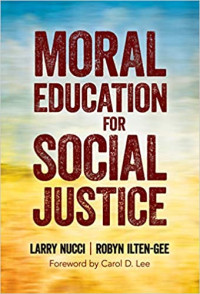 Teachers College Press, 2021, 240 pages.
Teachers College Press, 2021, 240 pages.
How can the fields of moral development and social justice education inform each other? One school of thought tends to be associated with more individualized, values-based judgments and actions and the other tends to focus on the social conditions that constrain individuals and groups. One may more readily use the language of “fairness,” while the other uses the language of “justice.”
In Moral Education for Social Justice, scholars Larry Nucci and Robyn Ilten-Gee explore how moral reasoning, critical pedagogy, and community activism come together, helping educators to see how these approaches complement each other and inform the ways we view teaching and learning.
To begin, the authors draw on research to define morality, distinguishing it from social or religious conventions and personal choices. In other words, deciding whether to steal something (moral) differs from choosing to wear a religious garment (conventional) or determining who you want to be your best friend (personal).
With a fundamental understanding of moral development, the authors explore how educators can create a moral classroom climate (in the thoughtful creation of school rules and the application of restorative justice practice). And the final section of the book focuses very practically on how to integrate moral development and social justice learning into your curriculum and instructional approaches. In this section, you’ll find strategies for leading productive student discussions and sample lesson plans, as well as action projects that are designed to respond to moral and ethical challenges (with a special focus on critical digital media literacy).
The authors propose that moral development lessons go hand in hand with students’ experiences as they work collaboratively, identifying “moral harm” or injustice, and responding with action plans that support positive social change.
PRIMED for Character Education: Six Design Principles for School Improvement, by Marvin Berkowitz
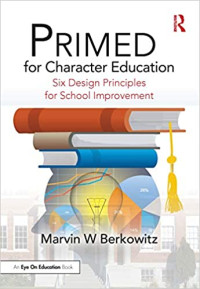 Eye on Education, 2021, 184 pages.
Eye on Education, 2021, 184 pages.
In his latest book, PRIMED for Character Education, developmental psychologist Marvin Berkowitz argues that “we can build a better world by understanding, committing to, and acting upon what is most effective in nurturing the flourishing of human goodness, especially in kids.” After the last two years, how can anyone argue with that?
But Berkowitz doesn’t stop at just naming what we’re educating for. In PRIMED, he offers a practical blueprint of how to make this vision a reality, starting with making character “THE most important goal of schooling.” This may be a leap for many schools that look to character education, SEL, mindfulness, and other prosocial initiatives to increase academic achievement, but he argues that “we must value nurturing goodness simply because goodness matters.”
For educators and school leaders who are tired of working in a demoralizing educational system that diminishes the human spirit in children and the adults who work with them, then PRIMED will come as a breath of fresh air. Reading it is like listening to Berkowitz speak (which I’ve done several times): matter of fact, insightful, confident—and bluntly honest. He doesn’t hold back when telling the reader that we, the adults, have to start with ourselves. He also doesn’t offer a list of character traits, avoiding the cultural and religious biases for which character education programs are often criticized.
Instead, his PRIMED framework (i.e., Prioritization, Relationships, Intrinsic motivation, Modeling, Empowerment, and Developmental pedagogy) helps educators see character as a way of being, not just doing. He also offers many inspiring stories, tools, and reflection exercises to help us get started with ourselves and our students (see here, here, and here for examples). The pandemic has given us an opportunity to rethink how we do education. Perhaps it’s time to try, as Berkowitz suggests, putting human goodness at the center.




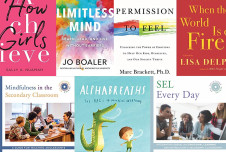

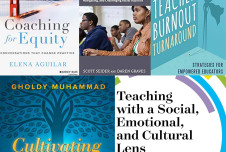
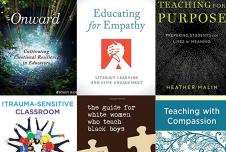

Comments